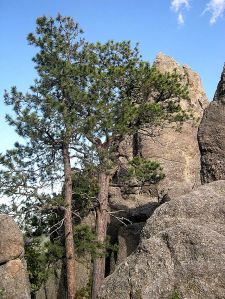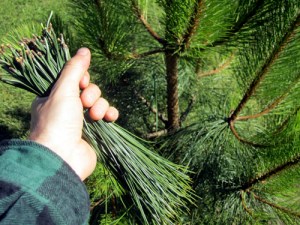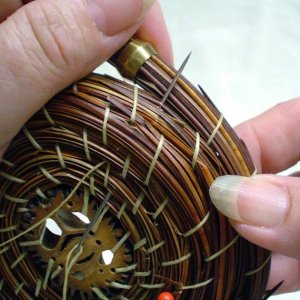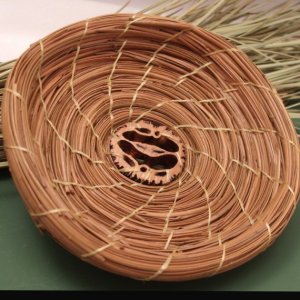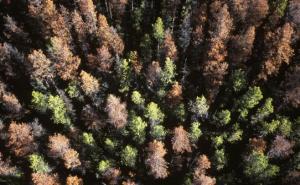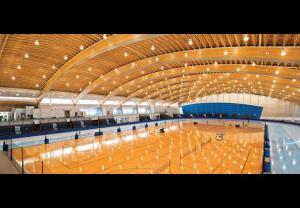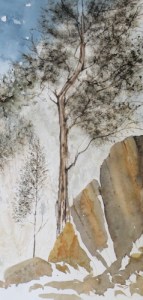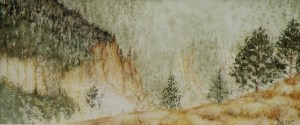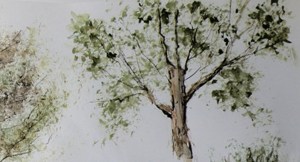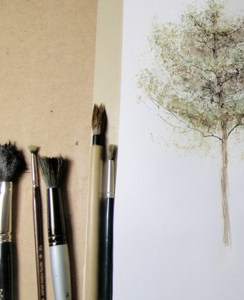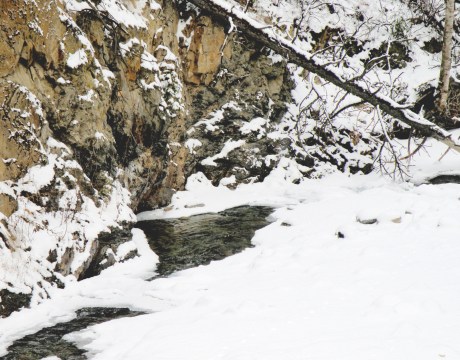Conjuring Up Wales
May 5, 2020
How does it go again? Oh yes….
I never saw a Moor —
I never saw the Sea —
Yet know I how the Heather looks
And what a Billow be.
Emily Dickinson (1830-1886)
I’ve not travelled a great deal. My idea of an exceptional journey would be choosing some smallish city or large village, renting an apartment over a shop for a month, then spending each day walking with my portable watercolour kit and folding chair to a different, yet close spot and becoming very familiar with it through drawing and painting and observing and experiencing–everyday a new, yet local viewpoint–getting to know one place well.
Not for me, these cruises or bus/rail excursions, trying to glimpse way too much, too quickly, itinerary-driven and herded about. It’s the visual equivalent of wanting everything at an all-you-can eat buffet–determined to defy the limitations of one’s plate by having it all.
Re-reading this paragraph, it comes off as pious and rather haughty. Truly many would find my notion of travelling more than just a little boring, and yes, possibly a recipe for loneliness. In any case, for all my grand proposing, I’ve never actually done it!
I do most of my travelling via imagination. So, here’s how I conjure up Wales:
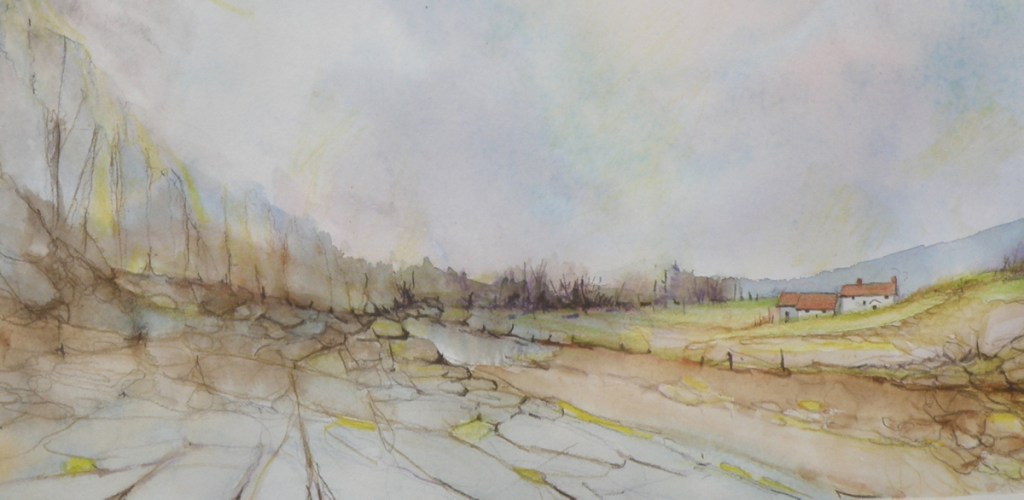
watercolour, 7″ x 12″, Arches #140 Hot Press Paper
by Lance Weisser
($150/matted, email: weisserlance@gmail.com)
Grass-fed and rather contented….
March 21, 2020
Although centrally located–and well within the city limits of Kamloops (pop: 97,000), British Columbia, Canada–we nonetheless hear cows bellowing distantly from the mountain range across the way from our house. This is cow country–beef cows–Herefords–grass-fed, and let out to pasture once Winter is past. Sitting out on our deck, I can just make out these tiny dots–Herefords most certainly–moving slowly across the great expanse of what is locally known as Strawberry Hill.
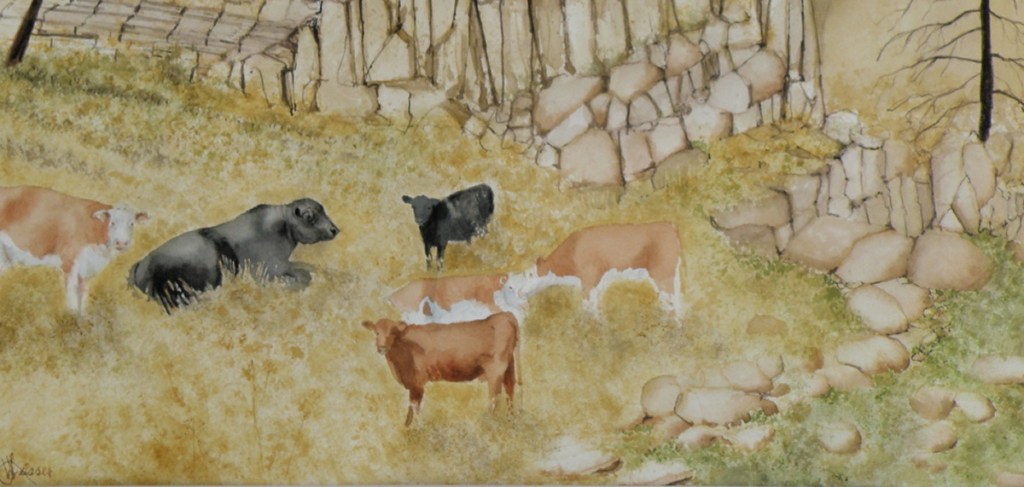
watercolour (detail of larger work), Arches Cold Press 140# Paper, 7.5″ x 14″
by Lance Weisser
During these unusual and routine-disrupted days, when everyone seems mildly ajar, pretending all is still fine, yet wondering what the heck to do with themselves, I find it reassuring to watch cows do nothing all day but search out grass on Strawberry Hill.
(And I’m sure many of you reading this have become even more thankful you have pursued painting or photography or writing as a mainstay in your life. These solitary-type endeavours are certainly now helping to anchor us amidst days of remarkable change and confinement.)
Here a ‘chuk’, there a ‘chuk’
March 2, 2019
Sometimes our guests awaken in the morning and come in the kitchen looking confused, ‘what is that strange sound coming from the back of the house? It sounds like a bunch of chickens being strangled.”
There are a number of birds named after their call–for example, the Whip-poor-will, Bobwhite, Killdeer and Chickadee. Now add to those the Chukar Partridge, which populates our back mountain ridge and does this: “Chu-Chu- Chuk-Chuk-Chuk-Chuk-ChukCHUKCHUKCHUK!!!!”
This is always the male progenitor of a brood (known as a covey) of some dozen or so chicks who often is announcing their collective descent down the ridge to wreak havoc in our vegetable garden. All one needs to do then is saunter down the back steps to suddenly frighten them to death as they go up in a giant, dreadful whir of feathers and squawking, after which the male will scold at me from atop the biggest rock, his ego bruised.
Native to Eurasia and Asia, including, Israel, Lebanon, Turkey, Iran, Afghanistan, Pakistan and India, along the inner ranges of the Western Himalayas to Nepal, Chukars were also introduced to Europe and N. America. [wikipedia]
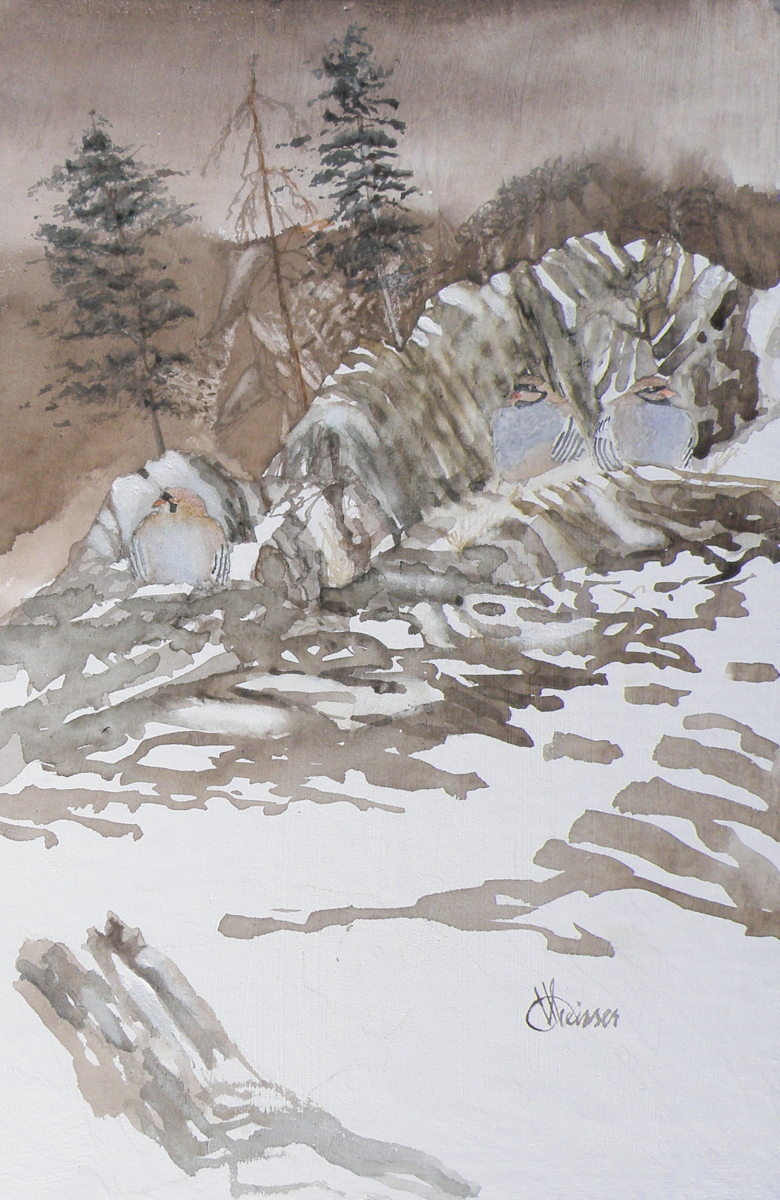
Lance Weisser
They are to me one of the strangest creatures I’ve ever come across.
They are either brazen as hell, or scared out of their freekin’ minds. Their markings are as odd as their call, their mannerisms are as odd as their habits (in our garden their choicest morsels are the tops of our onions–I mean, who eats the tops of onions?)
When you google them as a subject, you usually find sites generated by hunters in the ‘Lower 48’ who are on the prowl for ‘the illusive Chukar Partridge’ all decked out in camouflage. I’ve yet to hear of any hunters in our area on the prowl for them, but believe me, we’ve got Chukars and they ain’t illusive.
Here’s one in action, for your listening pleasure: https://www.youtube.com/watch?v=q09GNpev6sk
The Old Rookery
February 21, 2019
EVERY SO OFTEN I go truant and abandon my blog, but at least this time around it hasn’t (quite) been an entire year (!) I might be alone in this, but my temptation is to spend so much time daily exploring the interesting posts of fellow bloggers that I end up spending less and less time actually painting. My solution to this apparent addiction is to leave my own posts in limbo until enough progress has been made to once again continue.
In any case, thank you for your patience and understanding, and here is my latest painting entitled ‘The Old Rookery’, depicting a scene from my imagination, drawing on the spirit of book illustrators from the days of my youth:

Thank you for reconnecting with me and I hope your Winter is going well for you!
Rock and Sky
May 1, 2018
We live in a very rocky place. Our house is situated just below a mountain ridge that is home to native varieties of cactus, sagebrush, tumbleweed, and the domain of Chukar Partridges, mule deer, black bear, a variety of hawks and owls, and the occasional Cougar.
Painting rocky scenes is something particularly satisfying due to the artistically-geometric shapes which become something of a foil for the full-blown and free-flowing movement of cloud and sky.
This was simply an experiment–discovering where shapes and natural design and configuration would lead–a painting begun without knowing where it might end.

‘The Home Place’, watercolour by Lance Weisser, 14″ x 16″, Arches Hot Press Paper
breakers
July 22, 2015
The depicting of waves in watercolour is particularly challenging when one has decided on being a ‘purist’ by refraining from both opaque white and masking fluid. Personally speaking, masking fluid has become so offensive in terms of smell (its natural thinner, in case anyone wonders, is ammonia, which is why it smells so awful–but a little ammonia will indeed thin thickened masking fluid, if stirred in slowly), and damaging brushes (even when dipping them in soapy water first), and causing the hardest of edges when removed, that it’s rarely a choice for me. It does make for quite lovely snow squalls when flicked from a stiff toothbrush, I must say–and great fun, too.

‘Third Beach, Vancouver’, watercolour, painted on location, 35.5cm x 23cm (14″ x 9″), Arches Hot Press 140lb. Paper
Breaking waves challenge any student of watercolour (and every single person working in this medium will forever be a student) because of having to leave paper white for crest foam, swash, and the receding backwash effects. This, coupled with understanding which part of the wave receives more or less pigment, not to mention the change of pigmentation if backwash is curling up and drawing in sand at the same time, comes the added realisation that sky is being reflected off top surfaces the further from shore one looks.
There truly is nothing for it but to get right into the actual physics of spilling, surging, plunging, and collapsing breakers, each of which exhibits its own characteristic properties–ones our eyes are very accustomed to and therefore recognize in a flash when viewing surf–properties a viewer expects to be reproduced in paintings (if the painting is trying to conform to the challenges of representational art, that is).
https://en.wikipedia.org/wiki/Breaking_wave Drawing each of these examples over and over again makes wave action less of a mystery and eventually becomes familiar and far less challenging. However, a single line of waves is always backed by more, multiplying the visual dynamics, adding to the confusion of having to depict row upon row of breakers. Where does foam end and the gathering wave behind it start? For this, it is very instructive to carefully observe photographs and again draw over and over how this actually does look.(https://en.wikipedia.org/wiki/Breaking_wave) Only then, personally speaking, do I find painting on location not as daunting, for stopped action is easier to analyze than sitting in front of actual pounding surf.
Painting water is a dedicated pursuit all of its own. There is a painting friend of mine who includes water in every single piece he does because he is dedicated to the depiction of water, whether in the form of rain, surf, river, lake, stream, waterfall, because in each case there is a lifetime’s worth of challenge.
mountain pine
June 20, 2015
In January 2011, a Pacific ponderosa pine in the Rogue River–Siskiyou National Forest in Oregon was measured with a laser to be 268.35 ft (81.79 m) high. This is now the tallest known pine. The previous tallest known pine was a sugar pine.
Ponderosa Pine photo by Jason Sturner
The needles are harvested by First Nations and other local artisans, then washed and woven into Ponderosa Pine needle baskets . . .
(photos: PineGardenBaskets, Etsy)
The mountain pine beetle is just over six millimetres long (about the size of a grain of rice). But the tiny forest insect has infested huge areas of mature pine around the interior of British Columbia, causing colossal amounts of damage on B.C. forests.
The beetle likes mature pine and mild weather. Because B.C. has more old pine than ever before, and has had several consecutive mild winters, mountain pine beetle populations have exploded to epidemic levels. (source + photo: Government of British Columbia)
Here in Kamloops, B. C., even pines growing in people’s yards get ravaged–as much as in our great forests. It is a helpless feeling, yet more and more innovative products are being developed from pine beetle timber.
Below is the Richmond, B. C., Olympic Skating Oval, totally made from pine beetle-killed timber. The wood has retained all the pine beetle bores and markings, and has been acclaimed as a ‘truly majestic work of art and design’.
photo: Architectural Review
tranquille creek gorge
June 3, 2015
ANCIENT FLOWS OF LAVA have left our regional landscape (Kamloops, B. C.) with dramatic canyons, a single lane dirt road skirting the edges.
MY PAINTING FRIEND MAX drove me through this arid landscape, only 10 minutes outside a city of nearly 100,000. Every so often she’d tell me of cars which had not been successful at executing a snowy, icy, tricky piece of road only to careen down the sides. At one place, the car was still there, making me both dizzy and almost nauseous, leaning over to see its rusting bulk caught between broken pines and rock.
‘MY GOD, WHERE WERE THEY HEADED?’ I’d asked. ‘Home, of course’, Max pointed ahead. And there was a small grouping of houses not far from the road, some fencing in horses or livestock–one had alpacas–and looking semi-deserted, though that was far from the case. Dogs barked at Max’s pickup as we threaded through and headed into yet more wilderness. ‘They take this road to Kamloops and back?’ — it seemed to my chicken, urban-minded guardedness a scary place to build one’s home. ‘Only for shopping, or a night on the town’, Max said. ‘Which is why someone sometimes doesn’t make it home–especially in the Winter.’
tortured brushes
May 12, 2015
THE BEST BRUSHES–in my wacked estimation–is a dollar store packet in the crafts section, next to those garish tubes of glitter and such. The second those poor things get home, they undergo an Edward Scissorhands attack that is not pretty.
SECOND-HAND STORES also usually have some wonderful, pathetic-looking excuses for brushes, pretty much being handed out for free.
VERY FEW BRUSHES I own get to keep their original shape except ones sized 0, 00, 000, and 0000. For some additional fine work, a nib pen loaded with watercolour does well also. But for large areas, chopped-up, hippie-freak brushes are like, tubular, man.
FORGET SABLE–even squirrel is too refined–woodchuck, maybe–and those synthetic sponges on handles used to paint walls with are good, too.
‘Mountain Mists’, 20cm x 28cm, Arches hot press 140 lb paper
THE TRUE ENJOYMENT OF PAINTING comes when viewing how another painter’s personal and unique need for self-expression realises itself in ways personal and unique. Interaction with the subject demands an approach which only the painter her/himself knows is right.
Finished work….”Logged-In”
April 16, 2015
Painting progression 1…. ‘Jamieson Creek Thaw’
April 2, 2015
JAMIESON CREEK is about a 15 minute drive from our home, along a dirt logging road. The Kamloops, British Columbia, region is a geologist’s dream come true, featuring some of the oldest mountains in Canada. As a student of watercolour, I am fascinated by stone and rock, particularly because it is so challenging as a subject.
This is Jamieson Creek, taken four years ago around February, early March….
And here is my initial drawing of the subject…..
As you can already see, photography is not my gift (which is why I paint, lol)–so forgive the darkness. It was taken, pre-dawn in the spare room which serves as a studio.
